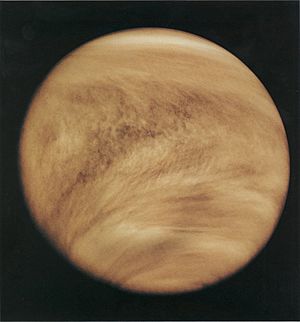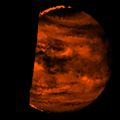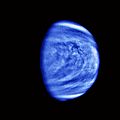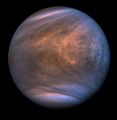Atmosphere of Venus facts for kids
The atmosphere of Venus is the thick layer of gases that surrounds the planet Venus. It's very different from Earth's atmosphere! Imagine a place where the air is super hot and incredibly heavy – that's Venus. This atmosphere is mostly made of carbon dioxide, which is the same gas we breathe out. Because of this thick, carbon dioxide-rich air, Venus is the hottest planet in our Solar System, even hotter than Mercury, which is closer to the Sun.
Contents
What is Venus's Air Made Of?
The air on Venus is mostly carbon dioxide, making up about 96.5% of it. The next biggest part is nitrogen, which is about 3.5%.
Small Amounts of Other Gases
Even though carbon dioxide and nitrogen are the main gases, there are tiny amounts of other gases too. These include:
- Sulfur dioxide
- Argon
- Water vapor (yes, a little bit of water!)
- Carbon monoxide
- Helium
- Hydrogen chloride
- Hydrogen fluoride
These other gases make up less than one percent of the atmosphere.
How Hot and Heavy is it?
The atmosphere of Venus is much hotter and thicker than Earth's.
- Super Hot: The temperature on the surface of Venus is around 467 °C (872 °F). This is hot enough to melt lead!
- Super Heavy: The air pressure on Venus is incredibly high. It's about 93 times stronger than the air pressure at sea level on Earth. Imagine having the weight of a deep ocean pressing down on you – that's how heavy the air feels on Venus.
Why is it So Hot?
The main reason Venus is so hot is because of its thick carbon dioxide atmosphere. Carbon dioxide is a "greenhouse gas." On Venus, this gas traps a lot of the Sun's heat, similar to how a greenhouse works. This effect makes the planet extremely hot, much hotter than it would be otherwise.
Clouds of Venus
The clouds on Venus are not like the water clouds we have on Earth. Instead, they are mostly made of sulfuric acid. These thick clouds cover the entire planet, making it hard to see the surface from space. They also reflect a lot of sunlight, which is why Venus looks so bright in our sky.
Studying Venus's Atmosphere
Scientists have sent many spacecraft to Venus to learn more about its atmosphere. Missions like Galileo and Akatsuki have helped us understand the extreme conditions and how the atmosphere moves. Future missions, like the planned DAVINCI+ probe, will even try to send a craft down through the atmosphere to gather more information.
Images for kids
-
1761 drawing by Mikhail Lomonosov in his work on the discovery of atmosphere of Venus
-
False colour near-infrared (2.3 μm) image of the deep atmosphere of Venus obtained by Galileo. The dark spots are clouds silhouetted against the very hot lower atmosphere emitting thermal infrared radiation.
-
Venus transits the face of the Sun on June 8, 2004, providing valuable information on the upper atmosphere through spectroscopic measurements from Earth
-
This image shows Venus in ultraviolet, seen by the Akatsuki mission.
See also
 In Spanish: Atmósfera de Venus para niños
In Spanish: Atmósfera de Venus para niños












